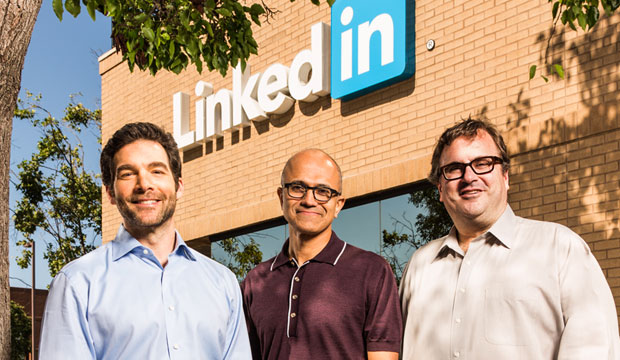Microsoft last week closed its US$26 billion acquisition of LinkedIn.
LinkedIn will remain a separate company and Jeff Weiner will continue as its CEO, but he now reports to Microsoft CEO Satya Nadella.
Integration of the companies’ products is under way:
- LinkedIn identity and network will be made available in Microsoft Outlook and the Office suite;
- LinkedIn notifications will be available within the Windows action center;
- Members of LinkedIn drafting their resumes in Word will be able to update their profiles, and discover and apply to jobs on the social network;
- LinkedIn’s Sponsored Content will be extended across Microsoft’s properties;
- Microsoft Active Directory and Office 365 will power Enterprise LinkedIn Lookup;
- LinkedIn Learning will be made available across the Office 365 and Windows ecosystems;
- A business news desk across Microsoft’s content ecosystem and MSN.com will be developed; and
- Dynamics 365 and LinkedIn Sales Navigator will be integrated to redefine social selling.
“Working across private and public sectors, we can create more opportunity for everyone to participate and share in economic growth,” Nadella said.
There’s Gold in Those Hills
“There are tremendous opportunities to leverage the LinkedIn database and profiles and Microsoft Office, Dynamics 365 and Microsoft’s social graph,” said Rebecca Wettemann, VP of research at Nucleus Research.
For example, bringing LinkedIn profiles into the overall intelligence of account management could drive “much more intelligent selling,” she told the E-Commerce Times.
“That, coupled with the integration of Delve into Dynamics 365, presents a whole new area of sales coaching and peer benchmarking opportunities,” Wetteman continued. Microsoft “could use Ofice, Delve and LinkedIn to produce the Fitbit equivalent to office productivity monitoring.”
Flies in the Ointment
It’s possible that Office 365 and Microsoft Dynamics users might not want LinkedIn notifications sent to them.
Microsoft President Brad Smith earlier this year pledged that IT admins and end users would be able to choose whether to display their LinkedIn profiles and activity information in the user interface.
“LinkedIn is how many people find jobs,” noted Michael Jude, a program manager at Stratecast/Frost & Sullivan. “What company actually wants to help their valuable employees to leave?”
It’s important for Microsoft to understand that it is “marketing into people’s personal networks,” he told the E-Commerce Times. “If Microsoft becomes the facilitator of personal networking, this could be a dandy way to capture the intersection of social media and business.”
Otherwise, both LinkedIn and Microsoft could be targets of angry users’ wrath.
“Microsoft isn’t Google, and they’re more driven by the needs of the businesses they serve over advertisers,” noted Rob Enderle, principal analyst at the Enderle Group.
“This prioritization difference should help with ensuring this type of decision will generally favor users and IT admins,” he told the E-Commerce Times. Still, Microsoft “will need to make the result compelling, or users will turn it off regardless of what IT admins do.”
Microsoft “will have to overcommunicate and overcompensate to win users’ trust,” suggested Nucleus Research’s Wettemann. “Users will have to have clear opportunities to opt in or out of how their profile and activity information is presented.”
There is a bigger problem, which is that Microsoft “has a mixed reputation with acquisitions,” Enderle noted. The companies’ greatest challenge will be ensuring that LinkedIn survives the integration and “becomes more relevant rather than less.”
More Money, More Markets
Microsoft this spring predicted its acquisition of LinkedIn would increase its total available market from $200 billion to $315 billion.
“The bigger benefit will be deeper engagement, with users making [Microsoft’s] solution far more critical,” said Enderle.
Microsoft “faces huge competitive pressure from Google now,” he noted, “and this could be their best defense against further Google-caused market erosion for Office.”
























































Social Media
See all Social Media